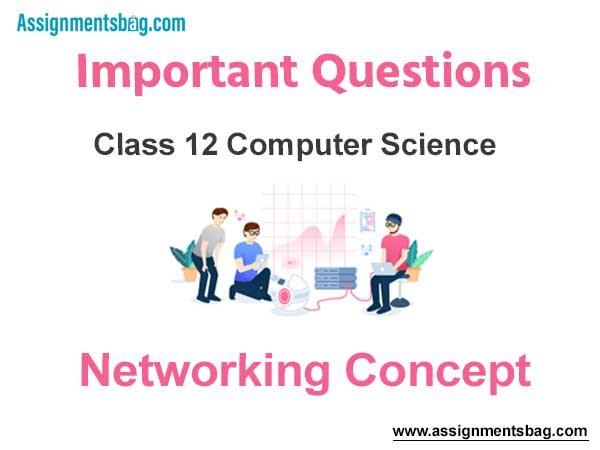Please refer to Networking Concept Class 12 Computer Science Important Questions with solutions provided below. These questions and answers have been provided for Class 12 Computer science based on the latest syllabus and examination guidelines issued by CBSE, NCERT, and KVS. Students should learn these problem solutions as it will help them to gain more marks in examinations. We have provided Important Questions for Class 12 Computer Science for all chapters in your book. These Board exam questions have been designed by expert teachers of Standard 12.
Class 12 Computer Science Important Questions Networking Concept
Short Answer Type Questions:
Question: What is WWW?
Ans: The World Wide Web is also called www or web or W3. It is a system of web servers. In www, information is stored in the form of web-pages. Web pages are written in HTML (Hypertext Mark Language). HTML defines the structural elements of web page. A web-page contains text, picture, audio, animations etc. The collection of related web-pages is called a website. Websites are stored on the web-servers. The web-pages of a website are linked with each other. These links are called hyperlinks. By default, hyperlinks are shown in blue color with underline. The first web-page of a website is known as Homepage.
Each web-site/page has a unique address. This address is called URL (Uniform Resource Locater). Example of URL is: www.google.com. To use these web pages, we have to use Web browsers. Some popular web browsers are Google Chrome, Firefox and Microsoft’s Internet Explorer.
Question: What is URL?
Ans: Each web page on the web has a unique name or address. This name or address is called Uniform Resource Locator. To access any webpage on the internet, we have to type the URL of website in the web-browser. Example of URL is:

Question: What is internetworking?
Ans: When two or more computer networks are connected with each other, it is called as computer internetworking. To inter-connect different networks, various types of devices are used such as router, gateway etc.
Question: Define the term communication channel?
Ans: Communication Channels are also called Communication Media. Communication channels are those channels which are used to transfer data from one computer to another in a network. Communication channels are of two types: Guided Media and Unguided Media.
Question: What is a Network?
Ans: Computer network is an interconnection of two or more computers to share resources (hardware, software or data). These computers are connected with each other using some communication medium. These communication medium can be wired (twisted pair cable, co-axial cable, fibre optics etc.) or wireless (Bluetooth, infrared etc.) There is no limit to the distance between computers in a network.

Question: Define the term Data Transfer Rate. What are its units?
Ans: The transfer of data from one computer to other is called data transfer. The amount of data that can be transferred from one computer to another in a given time period (usually a second) is called Data Transfer Rate. Data transfer speed is expressed in bits. Units of data transfer rate can be:
kbps – kilo bits per second
mbps – mega bits per second
gbps – giga bits per second
tbps – tera bits per second
Question: What do you understand by the term Transmission media?
Ans: Communication Media is also called Communication Channels. Communication channels are those channels which are used to transfer data from one computer to another in a network. Communication channels are of two types: Guided Media and Unguided Media.
Question: What is network topology?
Ans: Network topology is the arrangement of the various elements (links, nodes, etc.) in a computer network. Computers can be connected in different ways in a network. So there are different types of topologies. Commonly used topologies are Bus topology, ring topology, star topology, mesh topology and tree topology.
Question: What is FTP and what are its uses or advantages?
Ans: It is a standard Internet protocol. These protocols are used to exchange files between computers on the Internet. FTP uses the Internet’s TCP/IP protocols to exchange files. It’s also commonly used to download programs and other files to our computer from other server computers.
Question: Name the devices that are used to connect a computer to an analog telephone lines. What are its different types?
Ans: It is the Modem that is used to connect a computer to an analog telephone lines. These modems are of two types: External Modem and Internal Modem.
• External Modem: It is a seprate device from the computer. It is connected with serial port COM1 or COM2 of the computer. These modems are more expensive than the internal modems. But these modems are faster then the internal modems.
• Internal Modems: It is a printed circuit board. It is attached in the system unit. These modems are cheaper then the external modems. These modems are also slower then the external modems.
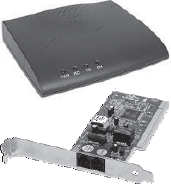
Question: What is a network hub and what are its uses or advantages?
Ans: Network hub is a communication device which is used to create a network. It is used to connect two or more Ethernet networks. After connecting networks with it, it represents the neworks as a single network. A hub can receive input from many lines. When hub receives input from any of the input lines, it sends the received data to all other lines of hub. Hubs are commonly used in the Star Network topology.
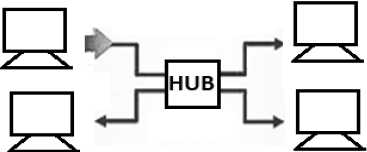
Long Answer Type Questions.
Question: Which type of network is useful for cable TV network? How it is different from WAN?
Ans: Cable TV network is such a network that spreads across a city. For such networks, MAN type of networks is used. Therefore, we can say that MAN type of network is useful for cable TV networks. These networks are different from WAN networks. WAN networks spread across the whole country or continent or world. In this way, we can say that cable TV networks are very small as compated to Wide Area Networks (WAN).
Question: What are guided and unguided data transmission media? Give examples.
Ans: The media through which data is transformed from one place to another is called transmission media. It is also known as or communication media. There are two categories of transmission media used in computer communications.
• Guided/Bounded Media
• Unguided/Unbounded Media

BOUNDED/GUIDED TRANSMISSION MEDIA: In this transmission media, signals are passed through a specific path using wire or cable. There are many types of bounded transmission media, such as twisted pair cables, co-axial cables, fiber optics etc.
UNBOUNDED/UNGUIDED TRANSMISSION MEDIA: Unguided or wireless media sends the data through air (without wires). This media is not guided or bounded to a channel to follow. Wireless media is particularly useful in those regions where cables are difficult to implement or install. The main types of unguided media are: Radio waves, Microwaves, Satellite Microwaves, Infrared waves.
Question: Why networking is needed?
Ans: Networking is needed mainly due to following reasons:
• To share computer resources
• To share hardware components
• To enable communication between computers
• To increase the spped and accuracy in communications
• To reduce the cost of data transfer
• To work in a team/group
Question: Why data sharing is considered as an important application of networking?
Ans: Data sharing is considered as an important application of networking. There are many reasons. Users can share data esily with the help of networks. For example: in an organization, users of different departments can share files easily with the help of network. Networking helps to increase the speed and accuracy of data communication. Data can be transferred to others within seconds using networks. Besides this, cost of data transfer using netowkrs is also very low. Using networks, a single task can be performed by dividing the work into team-groups. It increases the productivity of work. Due to these reasons we can say that data sharing is considered as an important application of networking
Question: What is the function of modem in networking?
Ans: Full form of Modem is Modulater Demodulator. It is a communication device. It is used to convert the digital signals into analog signals and vice versa. Computer generates digital data which is not suitable for long distance communication. So, this data must be converted to analog data for long
distance communication. It is the modulation which converts digital data into analog data. This analog data can travel without any noise over long distance. When this data riches at its destination, then it is converted back to digital data. This process of analog to digital conversion is called demodulation. In this way, we can say that modems play an important role in communication.
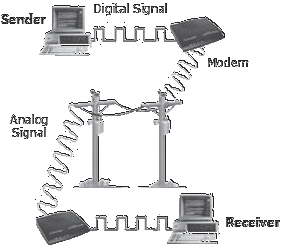
Question: What are networks? Explain different types of networks.
Ans: Computer network is an interconnection of two or more computers to share resources (hardware, software or data). These computers are connected with each other using some communication medium. These communication medium can be wired (twisted pair cable, co-axial cable, fibre optics etc.) or wireless (Bluetooth, infrared etc.) There is no limit to the distance between computers in a network.
Types of Networks:
There are many types of networks. Networks can be classified according to span of their geographical area. They can be classified into three categories:
1. Local Area Network (LAN)
2. Metropolitan Area Network (MAN)
3. Wide Area Network (WAN)
1. Local Area Network (LAN): A LAN netowkr interconnects computers within a limited area. This area can be a residence, school, library, or office building. LAN is relatively smaller than MAN and WAN. It is privately owned network. It provides local connectivity. In Offices, LAN is used to share resources. It can also be used to exchange information.
2. Metropolitan Area network (MAN): MAN networks are larger then a local area networks. It covers a large geographical area as compared to LAN. It can be the area of an entire city. MAN may be a single network like cable TV network. It may be interconnection of many LANs. For example, a company can use MAN to connect it’s all office LANs in a city. MAN might be either private or public. MAN is slower than LAN but Faster than WAN.
3. Wide Area networks (WAN): These are the largest neworks. These networks have no limit of geographical distance. This geographical area can be a country, a continent or the whole world. Public networks can be used to connect computers in a wide-area network. For example, telephone network system is used to connect computers to WAN. WANs can also be connected through satellites. Internet is the best example of Wide Area Network. Many components are used in WAN. These components are Bridges, Routers, and Gateways etc. Railway, airlines and banks etc. are the main application areas of WAN. WAN is slower than LAN and MAN.
Questions: What are network topologies? Explain different types of network topologies.
Ans: Network topology is the arrangement of the various elements (links, nodes, etc.) of a computer network. Computers can be connected in different ways in a network. So there are different types of topologies. Commonly used topologies are discussed below:
Bus Topology:
A bus network is a local area network (LAN). It is the simplest network topology. In this topology, all the nodes (computers as well as servers) are connected to the single cable. This cable is called the Bus. This central cable is the backbone of the network. Every node communicates with the other nodes through this Bus. A terminator is added at ends of bus. It prevents bouncing of signals.
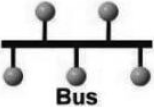
Star Topology:
A star network is a local area network (LAN). In this topology, all the components (nodes) of network are connected to the central device. This central device is called Hub. The connection between nodes and central device is point-to-point. Every node is indirectly connected to every other node by the Hub. All the data passes through the central device. Unshielded Twisted Pair (UTP) Ethernet cable is used to connect workstations to the central node.

Ring Topology:
A ring network is a local area network (LAN). In Ring Topology, all the nodes are connected to eachother like a closed loop. Each node is connected to two other nodes on both sides. A node can communicate with its neighbouring nodes. In the network, data travels in one direction. Sending and receiving of data takes place with the help of TOKEN. A Token contains the information about the sender and receiver.

Mesh Topology:
A mesh network is a local area network (LAN). In this topology, all nodes are interconnected with one another. This type of topology is very expensive. It is commonly used in wireless networks. In this topology, each node is directly connected with all other nodes of a network. Flooding or routing techniques are used in mesh topology for communication.
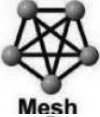
Tree Topology:
It combines the features of Star and Bus Topology. In Tree Topology, the numbers of Star networks are connected using Bus. This topology is also called Expanded Star Topology. Ethernet protocol is commonly used in this type of topology.

